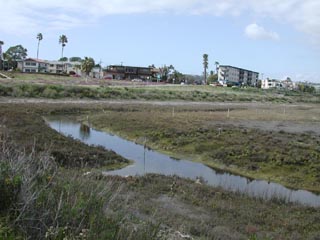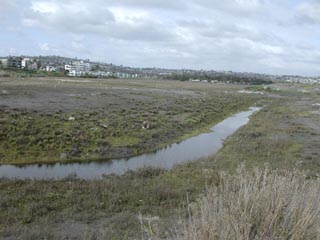Recovery of trophic function in a restored Pacific coastal wetland (with C. Currin) California Sea Grant (3/01-2/03)
ABSTRACT:
Response of benthic communities to changing flushing regimes
in a Southern California lagoon
The Southern California coast is dotted with coastal lagoons and embayments.
Typically, geographically small with episodic freshwater input linked
to rain events, these lagoons also receive significant inputs of energy,
nutrients and organisms from the sea. Occasionally, lagoons close for
extended periods or during specific reproductive seasons, possibly causing
key species with life cycles dependent on ocean flushing and transport
to disappear. Because plant cover is a main source of spatial heterogeneity
in Pacific coast wetlands, changes in plant community can influence the
abundance and diversity of benthic invertebrates. The objective of this
research was to determine responses of the seagrass, Ruppia maritima L.
and associated benthic communities to changing ocean flushing conditions
in San Dieguito Lagoon.
San Dieguito Lagoon contains approximately 260 acres of wetland habitat
that forms the lower part of the San Dieguito River valley. This lagoon
opens and closes regularly based on rainfall amounts and flood scour.
In October of 2002, San Dieguito River inlet was breached after an extended
8-month closure. The lower salinity, higher temperature water that resulted
post-breach coincided with changes in abiotic sediment properties, with
changes in plant distribution, and with changes in the benthic invertebrate
community. Pre-breach, tidal flats were dominated by R. maritima but were
largely unvegetated after opening the inlet. With the significant decrease
in R. maritima cover, porewater salinity increased, porewater temperature
decreased, and sediment redox values became more positive. Multivariate
analysis indicates differences between pre- and post-breach seagrass fauna
composition, partially due to increases in opportunistic species, such
as Capitella capitata complex. After breaching the inlet, the seagrass
infauna communities also exhibited an increase in diversity and evenness.
Understanding the benthic community alterations due to changes in plant
cover and in flushing regime will increase knowledge of complex wetland
interactions and aid conservation of Southern California lagoon ecosystems.
METHODOLOGY: Research will involve a series of mensurative experiments (using natural heterogeneity) and manipulative experiments conducted within the restored and natural salt marshes of Mission Bay California. Trophic function, defined through evaluation of food web architecture, interaction strengths, and complexity, will be determined using (i) using identification of invertebrate and fish gut contents (light microscopy, SEM and HPLC analysis of gut pigments), (ii) stable isotopic analyses (d13C, 15N and 34S) of primary organic matter sources and consumers, (iii) infaunal food preference and assimilation experiments conducted in the laboratory and (iv) in situ tracking of trophic pathways via isotopically labeled benthic food sources. Manipulation of light (shading experiments), plant cover (clipping), and sediment parameters (transplants and organic amendments) will be carried out to identify factors controlling benthic microalgal availability and composition, and the role of benthic microalgae in promoting faunal colonization and typical trophic linkages within created marshes. Near the end of the study, food web architecture in other southern California created marshes (Tijuana River Estuary [2 yr old] and San Diego Bay [18 y old] will be compared with that in Mission Bay
RATIONALE: Loss of coastal salt marsh habitat is a widespread problem in southern California that continues in the face of conservation efforts. Marsh restoration and creation have become standard mitigation measures to compensate for marsh loss in California and elsewhere, despite some uncertainty about their effectiveness. There is broad recognition that effective marsh restoration must achieve recovery of function in addition to structural attributes, but functional measures have been especially elusive. A major function of California salt marshes is trophic support for shellfish, fish and birds.Trophic functions (food web architecture, interaction strengths, complexity), which have received little attention in restored wetlands, will be the focus of this proposal.
ACCOMPLISHMENTS: We will identify primary
producers key to salt marsh trophic support functions and identify marsh
design criteria that promote development of trophic pathways characteristic
of natural marshes. A protocol will be developed for target species which
describes sampling, analysis and interpretation of marsh trophic function
and for comparison to reference sites. This protocol will be suitable
for use by those monitoring restoration projects or change (e.g., degradation)
in natural systems. In addition, recommendations will be generated for
wetlands design and construction, to promote rapid development of trophic
function in created marshes. These will take the form of publications
and manuals, available for use by businesses and agencies responsible
for the design, construction, monitoring and oversight of wetlands restoration
programs.

Muddy region of the Crown Point Mitigation Site, Mission Bay, CA; Marsh
age: 6 yrs

Sandy region of the Crown Point Mitigation Site, Mission Bay CA; Marsh
age: 6 years
Levin, L. A., IOD, Scripps Inst. Ocean., La Jolla, CA, USA, llevin@ucsd.edu
Currin, C., Nat. Ocean Service, NOAA, Beaufort, NC, Carolyn.Currin@noaa.gov
Neira, C. IOD, Scripps Inst. Ocean., La Jolla, CA, USA, cneira@coast.ucsd.edu
McMillan, P., IOD, Scripps Inst. Ocean., La Jolla, CA, USA, pmcmillan@ucsd.edu
Mendoza, G., IOD, Scripps Inst. Ocean., La Jolla, CA, USA, guillmendoza@hotmail.com
Whitcraft, C., IOD, Scripps Inst. Ocean., La Jolla, CA, USA, cwhitcra@ucsd.edu
Gonzalez, J., IOD, Scripps Inst. Ocean., La Jolla, CA, USA, jpgonzal@ucsd.edu
Carman, K., Dept. of Biol. Sci, LSU, Baton Rouge, LA, USA, zocarm@lsu.edu
IMPROVED UNDERSTANDING OF LARGE-SCALE TROPHIC SUCCESSION THROUGH SMALL-SCALE ISOTOPIC ENRICHMENT EXPERIMENTS
Of the many factors regulating succession in benthic marine communities, food has commanded relatively little attention. In California tidal wetlands, disturbance, restoration and plant invasions induce shifts from microalgal-dominated to plant-covered sediments. By enriching algae or bacteria with C-13 and Spartina or cyanobacteria with N-15, we are able to identify those infaunal taxa that preferentially feed on each food source, or C and N derived from these. Experimental results combined with time-series community data reveal that large-scale shifts in community structure in restored salt marshes (from insect to annelid-dominated assemblages) and Spartina-invaded tidal wetlands (from surface to subsurface feeders) are likely to be caused by changes in food availability.
2003 Am. Society of Limnology and Oceanography Meeting
| Related Downloads: | |
Download Talley and
Levin2001 |
|